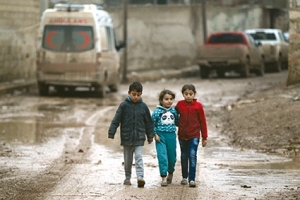The Syrian Safe Zone: The De-Escalation Process
There are many stakeholders in this dire situation who want to ratify a possible working solution for the “Syrian Crisis”. However, efforts to form said solution are not based on altruistic reasons, from each actor’s desire to see substantial peace in Syria, and much of the “Syria Talks” resemble little more than a game between state actors, each of whom has their own discerning interests and sought-after benefits regarding Syria: the goal of the game being for the actors on one team to outmaneuver the actors on the other.
The Syrian Peace Talks in Astana (SPTA) are one of those “cul-de-sacs” offering little to obstruct the escalation and lacking the substantive agreement of previous unsuccessful rounds of talks. However, four-fifths of the May proposal by Russia in the third round that took place in Astana, Kazakhstan, may constitute “hope” or a possible outcome to end the six-year conflict that turned the country to rubble and cost more than 400,000 lives. The SPTA was held under the auspices of the United Nations, and observed by the United States.
Three countries- Russia, Turkey, and Iran -who endorsed the negotiations, said yes to outlining the “safe zones”. There are still facts on the ground that suggest the implementation and enforcement of the agreement demands time, resources and good faith from the participating actors, yet the agreement came into effect following the guarantors’ signing on Saturday. The countries maintaining the four zones will convene to form a commission at the end of May to work on the plan.
The Safe Zone Agreement is basically planned to mitigate the violence and cease the war between rebels, supported by Turkey and the government of Bashar al- Assad, backed by Russia and Iran. The four zones will be implemented in four Syrian provinces:
ZONE 1- Idlib province: Combining northeastern areas of Latakia province, western areas of Aleppo province and northern areas of Hama province in which one million civilians live. Al-Qaeda and its factions are dominant in this region.
ZONE 2- The Rastan and Tailbash: An enclave located in northeast Homs province which has 180,000 civilians. Al-Qaeda and its allies operate in this region.
ZONE 3- Estern Ghouta: Located in the northern Damascus countryside, it has 690,000 civilians. Jaish Al-Islam controls the region, one of the rebel factions that participated in the SPTA.
ZONE 4- Deraa and Quneitra: Provinces that have a border with Jordan, controlled by rebels and having a civilian population of around 800,000.
Safe Zone, by definition, means a “non-conflict” zone where civilians are protected and kept safe from any group fighting in Syria. It is a law of war assuring that civilians are protected. Zones will be open to humanitarian access and public services, and infrastructure will be provided in areas where there has been a lack of electricity and water since the war broke out. The refugees will also be able to return to their homes if the safe zone is implemented.
The No-Fly Zone means no warplanes from Bashar Al Assad’s forces will be able to fly over the safe zones. Russian aircraft can fly over them, but cannot carry out air raids. A coalition led by the USA and guarantor countries will be able to attack ISIL strongholds and other Al-Qaeda affiliated group outside those four zones. When the demarcation of the Safe Zones is complete, the three countries’ military personnel will be deployed to the checkpoints and Safe Zones to begin the securing and de-escalation process.
Talks are ongoing at the United Nations in Geneva. Russia has scheduled another talk in Kazakhstan in late July to outline the plan. The United States is concerned over the Iranian involvement in the peace process, claiming that Iran has not brought any positive efforts to solving the Syrian conflict. Members of the Syrian Opposition have also walked out of the talks, rejecting Iran’s role in the SPTA. With these developments over talks that may shape the future of Syria, it is undeniably clear that Syrian people are in need of stability and peace in their war-torn country. The SPTA might bring optimism to the people now, and it falls on the international community to shoulder this possibility.
Abdulmelik Alkan












